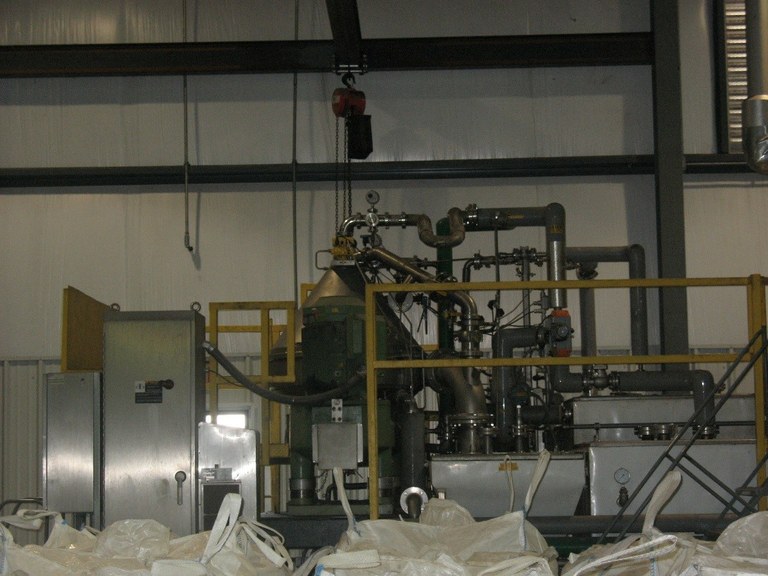Effects of Corn or barley with low or medium fat dry distillers grain with corn silage in growing and finishing steers diets.
Objective: Investigate the effects of oil removal from distillers when fed with corn or barley on growing and finishing performance of steers.
Research has established that the distillers grain (DDG) by product that results from ethanol production is an excellent livestock feed resource particularly for feedlot cattle. However, as the ethanol industry continues to develop and advance so does technology within the ethanol industry. The use of centrifuge technology to spin off a portion of the corn oil has resulted in DDG with lower oil content. The resulting DDG has changed from originally having about 12% crude fat to a medium fat level between 8-10%. Additionally, some ethanol plants also use a fractionation technology that allows them to lower the fat content of the resulting DDG to around 5%. Fat is considered an energy source in feedlot diets. With the reduction in the fat content of current DDG, the industry needs to know how this has affected the feeding value of DDG and how the new medium and low fat DDG feedstuffs interact with other feedstuffs that may be fed.

Centrifuge that removes fat during ethanol production.

We recently completed a feedlot growing (57 days on feed) and finishing study (133 days on feed) to evaluate two fat levels of dry corn distillers grains (DDGS; 5.8% and 9.6% fat) with diets containing corn or barley and corn silage. The primary objective of the study was to investigate the effects of oil removal from distillers when fed with corn or barley on growing and finishing performance of steers.
One hundred and fifty-four head of weaned crossbred feeder calves (685 pounds initial body weight) were used to evaluate the effects of feeding medium (9.6%) or Low (5.8%) fat DDGS with corn or barley grain. Steers were blocked by initial body weight and randomly assigned to one of 16 pens (9-10 animals/pen) at the NDSU Carrington Research Extension Center Livestock Unit. Each pen within a block was randomly assigned to one of 4 treatment diets: 1) Corn with medium fat DDGS; 2) Corn with low fat DDGS; 3) Barley with medium fat DDGS; 4) Barley with low fat DDGS (Table 1 and 2). The first 57 days on feed the cattle were fed a backgrounding ration, then for the remaining 133 days on feed they were fed a finishing ration. Cattle were marketed to a commercial packing plant and carcass data was collected on all animals.
Results: For both the growing and finishing periods there were no statistical interactions for grain source (corn or barley) and DDGS type (medium or low fat). Therefore, all data is presented as the main effects of corn vs. barley and medium fat vs. low fat DDGS. There were no statistical differences between DDGS type for live animal performance parameters for live weight, average daily gain (ADG), dry matter intake (DMI), or gain to feed for both the growing and finishing phases (Table 3). Corn and barley diets resulted in similar live weights and similar average daily gain for both the growing and finishing periods. However with the exception of DMI for the growing phase, DMI for corn was greater than barley diets for the finishing period and overall for the whole 190 days on feed. With similar average daily gains for these periods for corn and barley, this also resulted in barley diets having greater overall gain to feed for the 190 days on feed. Carcass characteristics were similar for both DDGS diets and the corn and barley diets (Table 4).
Implications: Barley grain showed improved feed efficiency over corn grain. Low fat and medium fat DDGS fed at 25% of the diet dry matter in diets with corn and barley resulted in similar animal and carcass performance for growing and finishing steers.
We have observed similar results in a previous research trial evaluating full fat (12%), medium fat (9%) and low fat (5%) DDGS in corn based finishing diets. In that work, while full fat had greater marbling scores than medium and low fat DDGS fed cattle, all other live and carcass performance parameters were similar for each fat level of DDGS.
Acknowledgements: Thank you to the North Dakota Corn Council for project funding, the Dakota Feeder Calf Show Consignors for providing the cattle, and the CREC livestock Unit technical staff for their care and feeding of the cattle.
Chanda Engel
Livestock Research Specialist


